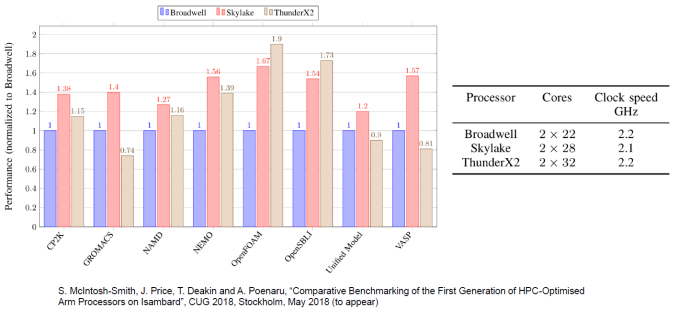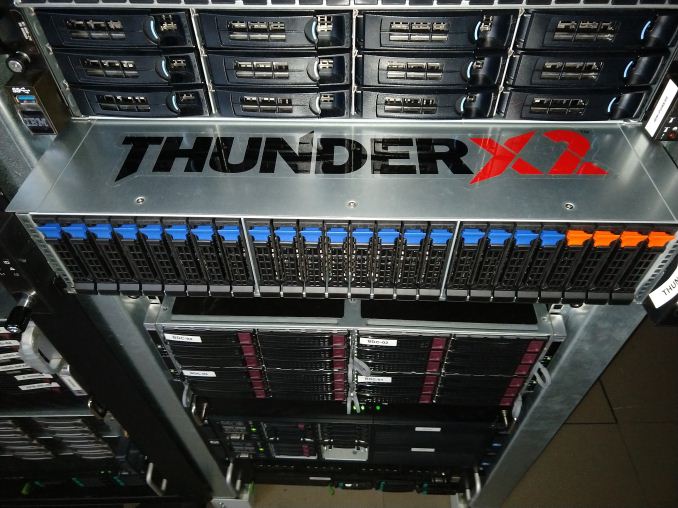Assessing Cavium's ThunderX2: The Arm Server Dream Realized At Last
by Johan De Gelas on May 23, 2018 9:00 AM EST- Posted in
- CPUs
- Arm
- Enterprise
- SoCs
- Enterprise CPUs
- ARMv8
- Cavium
- ThunderX
- ThunderX2
What We Can Conclude: So Far
Wrapping things up, our SPECInt analyses show that the ThunderX2 cores still has some weaknesses. Our first impression is that branch intensive code – especially in combination with regular L3-cache misses (high DRAM latency) – run quite a bit slower. So there will be corner cases where the ThunderX2 is not the best choice.
However, other than some niche markets, we are pretty confident that the ThunderX2 will be a solid performer. For example, the performance measurements done by our colleagues at the University of Bristol confirm our suspicion that memory intensive HPC workloads such as OpenFoam (CFD) and NAMD.run really well on the ThunderX2
From the early server software testing we have done so far, we can only be pleasantly surprised. The performance-per-dollar of the ThunderX2 in both Java Server (SPECJbb) and Big Data processing is – right now – by far the best in the server market. We have to retest AMD's EPYC server CPU and a Gold version of the current generation (Skylake) Xeon to be absolutely sure, but delivering 80-90% of the performance of the 8176 at one fourth of the cost is going to very hard to beat.
As an added benefit to Cavium and the ThunderX2, here in 2018 the Arm Linux ecosystem is now mature; specialized Linux kernels and other tools are no longer necessary. You just install Ubuntu Server, Red Hat, or Suse, and you can automate your deployments and software installation from the standard repositories. That is a massive improvement compared to what we experienced back when the ThunderX was launched. Back in 2016, simply installing from the regular Ubuntu repositories could cause problems.
So all in all, the ThunderX2 is a very potent contender. It might even be more dangerous to AMD's EPYC than to Intel's Skylake Xeon thanks to the fact that both Cavium and AMD are competing for much of the same pool of customers considering switching away from Intel. This is because the customers who have invested in expensive enterprise software (Oracle, SAP) are less sensitive to cost on the hardware side, so they are much less likely to change to a new hardware platform. And those people have been investing the past 5 years in Intel as it was the only option.
That in turn means that those who are more agile and cost sensitive, such as hosting and cloud providers, will now be able to choose an Arm server CPU alternative with an excellent performance-per-dollar ratio. And with HP, Cray, Pengiun computing, Gigabyte, Foxconn, and Inventec all offering systems based upon the ThunderX2, there isn't a shortage of quality vendors.
In short, the ThunderX2 is the first SoC that is able to compete with Intel and AMD in the general purpose server CPU market. And that is a pleasant surprise: at last, an Arm server solution that delivers!












97 Comments
View All Comments
Davenreturns - Wednesday, May 23, 2018 - link
In the spec table for the AMD EPYC 7601 you have max sockets 4 and PCIe 3.0 lanes as 64. I thought the max sockets was 2 and that the total number of PCIe 3.0 lanes was 128 (64 in a dual socket machine).davegraham - Wednesday, May 23, 2018 - link
max sockets is 2 and PCIe lanes is 128 (64 from each 7601 for a combined total of 128; remember, each 7601 has 128 PCIe lanes by themselves. 64 from each are ganged together for IF in a 2P system).davegraham - Wednesday, May 23, 2018 - link
*are not *isDavenreturns - Wednesday, May 23, 2018 - link
But in a single socket motherboard system, the total PCIe lanes available from one EPYC processor is 128 which I think we are both saying is correct.Davenreturns - Wednesday, May 23, 2018 - link
The reason I think these two corrections are important and should be addressed by the author is the way the players in the market are competing. The table should read 128 PCIe lanes and 2 sockets max for EPYC. One only needs to look at AMD's EPYC One socket page to understand why it is important.https://www.amd.com/en/products/epyc-7000-series-1...
The page is filled with marketing trying to convince customers that you are actually getting a two socket server in just one socket. And yes 128 PCIe lanes are available to the customer in these one socket products as part of the reasoning.
The max number of sockets is also important. AMD and probably Cavium are both arguing that 90% of the market only needs 1 or 2 sockets. Intel doesn't agree and provides 4 or more socket configurations.
The one socket argument centers around the I/O and memory channels available in the AMD processor. Even though the table just might have typos, reviewers around the web had a hard time believing that a single chip offered 128 lanes of PCIe connectivity and I found a lot of misinformation. It continues today.
DanNeely - Wednesday, May 23, 2018 - link
AFAIK even for intel 1/2 socket machines are around 90% of their sales. They're just selling enough total server chips in total that catering to the sliver of the market that does want 4/8way configurations is still worth their time.Arnulf - Sunday, May 27, 2018 - link
Profit margins in that market segment are likely to be way higher so it's worth it for Intel as long as there is no competition, forcing prices downwards.Ryan Smith - Wednesday, May 23, 2018 - link
You are correct. Thanks for pointing that out.Davenreturns - Wednesday, May 23, 2018 - link
Thanks so much, Ryan.vanilla_gorilla - Wednesday, May 23, 2018 - link
"This is because the customers who have invested in expensive enterprise software (Oracle, SAP) are less sensitive to cost on the hardware side, so they are much less likely to change to a new hardware platform."I don't really follow the logic here. Just because you spend a lot more money on software doesn't mean you wouldn't try to save money on hardware. You don't only focus on one related expense because it's larger.